|
•
W H E R E IN R O M E •
Don't miss shows in Rome
N
•
A •
V •
O •
N •
A S
•
Q
•
U
•
A
•
R •
E
|
Roman places worth to be seen |
|
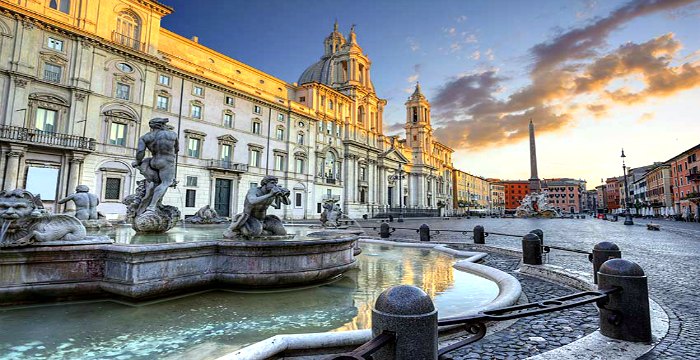
:: Navona Square ::
|
|
|
Navona Square
Piazza Navona is a Baroque temple, the heart of Roman tradition, a living and loved place
by Romans and tourists.
An unforgettable square with its fountains, churches and street artists.
Among the most famous Roman squares, this baroque gem offers to all art
lovers a large number of masterpieces in its perimeter: masters such us
Bernini, Borromini, Rinaldi and Pietro da Cortona left them mark with
immortal masterpieces such as the Fountain of the Four Rivers, the
church of Sant’Agnese in Agone and the frescoes of Palazzo Pamphilj.
Its history dates back to the first century AD, when there was the
emperor Domitian, when the homonym stadium was built that hosted the
track and field events, some of which memories are guarded in the nearby
Via Zanardelli.
Always used as a landing for its picturesque street artists, if you want
to bring home your portrait or a characteristic glimpse of the city.
During Christmas the square changes in order to offer fine glass
decorations, nativity scene papier-mâché characters and all sorts of
overly sweets and gift ideas.
Piazza Navona is the heart of Roman tradition, a living and loved place
by the population and tourists who are fascinated by it, with its large
number of restaurants, wine bars and pubs in the surroundings.
|
|
|
Don't miss "show" in Rome
P
•
A
•
N
•
T
•
H
•
E
•
O •
N
|
Roman places worth to be seen |
|
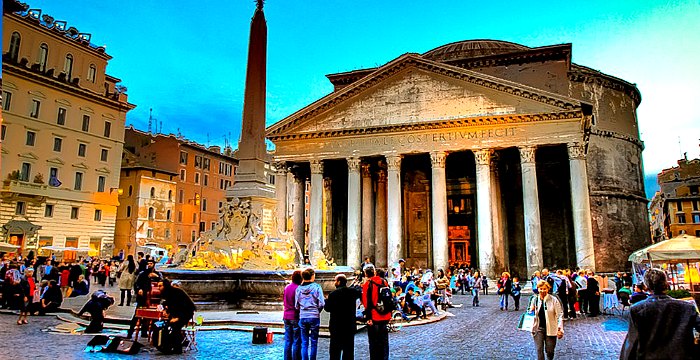
:: Pantheon ::
|
|
|
Pantheon
The Pantheon of Rome was initially a pagan place of worship. Then it
became a Christian church and a mausoleum for illustrious men.The
Pantheon is a masterpiece of engineering. The perfectly spherical space
gives a feeling of extraordinary harmony and balance, also thanks to the
light/shadow complex effects of niches and shrines. The wide round hall
at the back of the pronaos is unparalleled in the ancient world. The
merging of the classical style (the colonnade and the pronaos) and a
typical Roman building (the Rotonda) is a compromise between the Greek
architecture, which focused mainly on the exterior, and the Roman one,
focused on the interior space. The majestic pronao is decorated with 16
huge 13m high, grey and pink granite columns. The 6.2 m wide walls of
the rotunda are made with Roma bricks and the concrete dome is the
greatest masonry dome ever built.
The dome it is the first example of this kind of roof in a temple.
DID YOU KNOW...?
Michelangelo thought the Pantheon had been built by angels, not men.
The Romans nicknamed it the ‘Rotonna, meaning ‘The Round place’, and
this is where the opposite square takes the name from.
Visiting hours: Mon-Sat 8:30 a.m.-7:30 p.m.; Sun and holidays: 9:00 a.m.-
1:00 p.m.Some time restrictions may occur during church services.
|
|
|
Don't miss "show" in Rome
C
•
A
•
M •
P •
O D
•
E •
I F
•
I •
O •
R
•
I
|
Roman places worth to be seen |
|
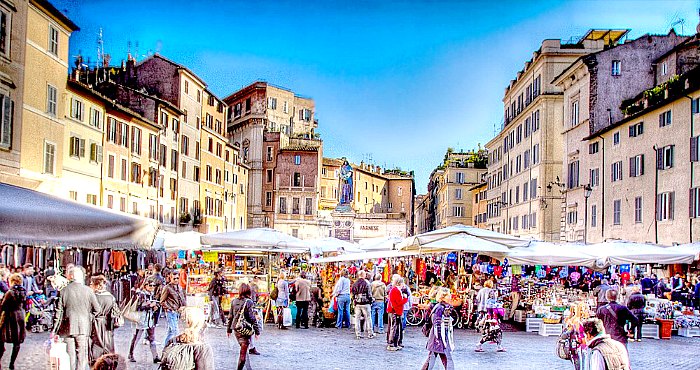
:: Campo dei Fiori Square ::
|
|
|
Campo dei Fiori Square
Rich in colours and sounds , Piazza Campo dè Fiori is one of the souls
of Rome; in the center overlooks the statue of philosopher Giordano
Bruno, who was condemned to the stake for heresy by the Inquisition.
Here in the morning you will find a picturesque market, but during the
night it is one of the favorite destinations of Roman nightlife. Place
of happy hours and after dinner, Campo de’ Fiori is a landmark for
nightlife.
The square, the only one that doesn’t have a church in Rome, hosts a
picturesque market in the morning which offers basic necessities and
rare delicacies from around the world.
The nearby Via dei Giubbonari is an important landmark of shopping, here
you will find some of the best shops of the city.
Doing a short walk you will discover Ponte Sisto, an evocative bridge to
reach the lively Piazza Trilussa and Trastevere, or the romantic Via
Giulia up to venture into the Jewish ghetto, where you will admire the
wonderful Portico D’Ottavia, another example of how the old and the new
can combine themselves to create the unique atmosphere of Rome.
A perfect starting point to easily reach the most famous sights of the
capital, from Piazza Navona to Pantheon, from Via del Corso to Piazza
Venezia up to Via dei Fori Imperiali, Campo de’ Fiori
means not miss a thing during your stay: the history of Rome, the
entertainment, shopping and art.
|
|
|
Don't miss "show" in Rome
T
•
R
•
E •
V •
I F
•
O •
U •
N •
T •
A •
I •
N
|
Roman places worth to be seen |
|
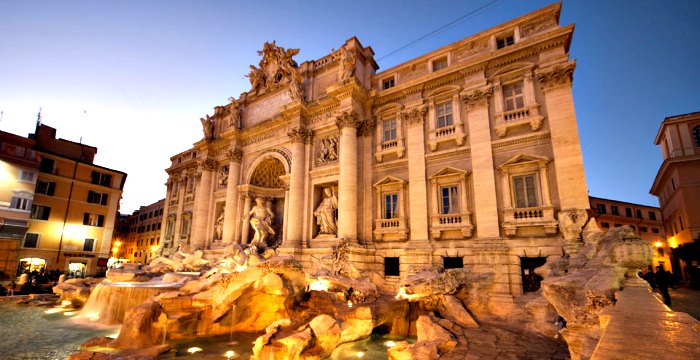
:: Trevi Fountain ::
|
|
|
Trevi Fountain
The Trevi Fountain is the largest and among of the most famous fountains
in Rome, as well as one of the most popular all over the world.The theme
of this masterpiece is the sea. The fountain is an example of perfect
fusion between Baroque sculpture and architecture.
Maybe not everyone knows that...
THE WATER OF LOVE: According to another legend, a girl whose beloved
leaves for the military service or for work will be ensure his eternal
love if she gives him a glass filled with water from the fountain, and
after he drinks she breaks the glass, so that he’ll never forget about
her.
THE LOVERS’ LITTLE FOUNTAIN: Another way of promising eternal love is to
drink at the Lovers’ little fountain, located on the right side, by the
Ace of Cups. The lovers just need to drink together to be faithful to
each other for the rest of their lives.
TREVI FOUNTAIN AND THE MOVIES: Even the movie world couldn’t remain
unaffected by the magnificence of the Trevi Fountain. The movie "Fontana
di Trevi" was shot in 1964 by Carlo Campogalliani (script by Federico
Zardi).
The monument is also featured in of the most famous Italian movies: "La
Dolce Vita" by Federico Fellini, where Anita Ekberg plunges in the
Fountain and invites Marcello Mastroianni to do the same.
Trevi fountain had previously been featured in the American movie "Three
coins in the fountain" (the fountain the title refers to is indeed Trevi
Fountain).
In ‘"Totòtruffa 62" Totò tries to sell the fountain to a gullible
tourist, including all copyrights on the pictures taken by other
tourists, leading to a number of gags and misunderstandings.
|
|
|
Don't miss "show" in Rome
S
•
A •
I •
N •
T P
•
E •
T •
E •
R B
•
A •
S •
I •
L •
I •
C •
A
|
Roman places worth to be seen |
|
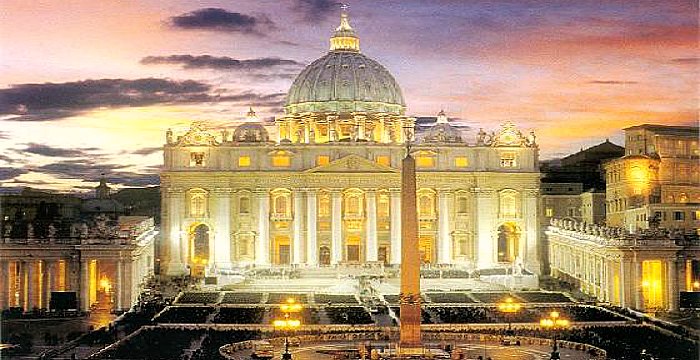
:: Saint Peter's Basilica ::
|
|
|
Saint Peter's Basilica
Saint Peter’s Basilica is a catholic church located within the Vatican
City, and overlooking Saint Peter’s Square.
The famous square, where pilgrims gather every day, is a marvellous
example of Baroque architecture and town planning.
The giant oval order of columns stretching across the end of the square
symbolizes two huge arms embracing the devotees.
As Bernini stated "Being almost like a matrix for all the other churches,
Saint Peter’s Basilica ought to have a colonnade welcoming everyone,
from the catholic believers to confirm their faith, to the heretics to
reunite them with the Church, to the infidels show them the true faith".The
triple colonnade relates to a topic of the Old Testament, where Ezekiel
describes the area outside God's Temple as a porticus incta portici
triplici, as well as a symbol of the Trinity Dogma.
As it is said in the paper records, the concave shape of the square
creates a "theatre" effect, because when the square is flocked with
people the crowd can see themselves, like in a cavea.
Saint Peter’s Basilica is the main papal basilica, the centre of the
Catholic religion, and is often referred to as the biggest church in the
world. The main catholic events, including the Pope proclamation, take
place there.
Architects like Bramante, Rapahel, Michelangelo, Maderno, and Bernini
designed the Basilica, and several other artists embellished it with
their statues and works of art.
In the right aisle is Michelangelo's Pietà (1499), a white marble
masterpiece now protected by a glass frame after being seriously damaged
by a mentally disordered person in 1972. In the left aisle is the Chapel
of the baptistery, designed by Carlo Fontana and decorated with mosaic
tiles. The aisle also contains the tombs of Pius X, John XXIII, and
Benedict XV.
DID YOU KNOW...? Saint Peter’s Dome is not only the symbol of the
Basilica itself but also of Rome and the Vatican City. It was built in
only two years' time by Giacomo della Porta according to Michelangelo’s
designs. It consists of two vaults placed one on top of the other, being
the internal one thicker and the external one a protection of the former.
The same design was used by Brunelleschi for the Dome of Florence.
Visiting Saint Peter’s Dome will allow you to enjoy one of the most
suggestive views of Rome, as long as you will toil for it. In fact, the
elevator will take you up to a certain height, and then you will have to
proceed on foot 330 steps up! Going up is not easy and as you proceed
the walls get narrower, so we advise anybody who suffers from
claustrophobia or vertigo against visiting it..
|
|
|
Don't miss "show" in Rome
C
•
A
•
S •
T •
E •
L S
•
A •
I •
N •
T
A •
N •
G •
E •
L •
O
|
Roman places worth to be seen |
|
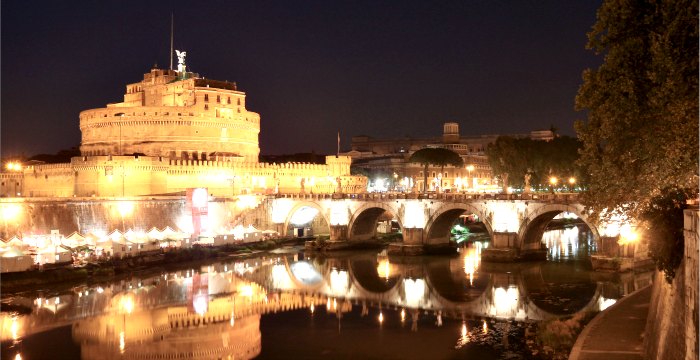
:: Castel Sant'Angelo
::
|
|
|
Castel Sant'Angelo
From mausoleum to fortress, from horrible prison to renaissance house
where also Michelangelo worked, from Risorgimento prison to museum,
Castel Sant'Angelo bears the memories of the Eternal City in its grand
rooms, solid walls and elegant frescoes, where past and present are
indissolubly linked to each other. The Mausoleum of Adrian or Castle of
the Holy Angel, is located on the right bank of the Tiber, opposite to
the Sant’Angelo Bridge near the Saint Peter’s Basilica and the Vatican,
in the Borgo district.
Castel Sant'Angelo was initially erected as a mausoleum by Roman emperor
Hadrian around 123 A.D. in a border area of the ancient Rome, and it was
used as a tomb until approximately 403 A.D., when Emperor Honorius
ordered its inclusion in the Aurealian Walls.
Since then, it was used as castellum (fortress) to protect the city.
Several Roman families competed for its possession: senator Teofilatto,
the Crescenzis, the Pierleonis, and the Orsinis. It was a memeber of
Orsini family, Pope Nicholas III, who connected the castle to St. Peter's
Basilica by a covered fortified corridor called the Passetto di Borgo.
In 1367 the building went to Pope Urban V, and since then many Popes
used the Passetto di Borgo as a refuge during dangerous times.
Thanks to it massive, fortified structure and its fame as an impregnable
fortress, the Castle hosted the Archive and the Vatican Treasure, but it
was also used as a Court and a prison (Giordano Bruno and Beatrice Cenci
were imprisoned there).
Still today visit the castle is a source of amazement thanks to the
magnificent views of Rome that can be admired from the heights of the
castle. Here you will find also interesting exhibitions and in summer
the gardens of the castle houses many events: music, food and readings
brighten up the hot summer evenings in Rome.
Being in a central location will allow you to easily reach Saint Peter’s,
Sant’Angelo Bridge, Piazza Navona and the Pantheon by feet.
The statue of an angel drawing his sword is located on top of the
building, reminding of Pope Gregory Magnum's vision during a procession
to pray God to end the plague.
The original statue was wooden, but it worn out. A second marble statue
was destroyed in 1379 during a siege and replaced in 1453 with a marble
angel with bronze wings. The angel was destroyed in 1479 by a
thunderbolt and replaced with a golden-bronze angel, which was melted in
1527 in order to manufacture cannons. A marble statue with bronze wings
by Raffaello da Montelupo followed (now in the yard of the Castle) and,
finally, in 1753 the current bronze angel by Pierre van Verschaffelt.
|
|
|
Don't miss "show" in Rome
V
•
A
•
T •
I •
C •
A •
N M
•
U •
S •
E •
U •
M
|
Roman places worth to be seen |
|
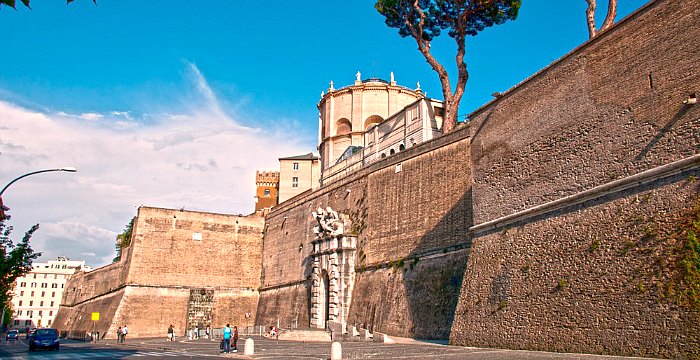
:: Vatican Museum ::
|
|
|
Vatican Museum
The first cluster of works exhibited in what was going to become the
Vatican Museum, consisted of a collection of statues.
Clement XIV and Pio VI founded the Pio-Clementino Vatican Museum,
containing works on display in buildings open to the public. Pio VII
significantly enlarged the collection by adding the Museo Chiaramonti
and the Braccio Nuovo.
The Museo Etrusco and the Museo Egizio, which are part of the Vatican
Museums, were founded by Gregory XVI, who took care of having Etruscan
pieces and Ancient Egyptian material coming from archaeological
excavations taken to Rome. He then assembled the works and monuments
already on display in other Roman museums. During San Pio X’s
pontificate, the Galleria Lapidaria, including 137 inscriptions of
ancient Roman Jewish graveyards, was added in 1910. The
Galleria degli Arazzi, including tapestries from the 16th and 17th
centuries, the Galleria delle Carte Geografiche, the Loggia di
Raffaello, the Chapel by Beato Angelico, painted during Nicholas V’s
pontificate, and the very famous Sistine Chapel, named after its founder
Sixtus IV and painted by Michelangelo, are just some of the masterpieces
boasted by the Vatican Museums. The Pinacoteca Art Gallery now located
near the new Museums entrance and boasting paintings by Pinturicchio,
Caravaggio, Leonardo da Vinci, and Raphael, as well as many more works
by the most famous artists, is also open to the public. A visit to the
Museum offers the chance to view a vast, beautiful collection
representative of the Italian history and art.
DON’T MISS Raphael’s Rooms: Originally part of the private apartment of
Pope Julius II, who commissioned the work to the famous painter they
were named after. Have a careful look at the School of Athens, a
beautiful fresco where philosophers Aristotle and Plato are depicted
surrounded by scholars. Someone holds that you may also distinguish the
figures of Michelangelo, who is the isolated man in front of the garden,
Leonardo, in the traits of Plato, and a self-portrait of Raphael, the
second figure in the right bottom corner.
Sistine Chapel: Have a close look at the wonderful frescoes by
Michelangelo, among which the most famous are The Creation of Adam and
The Last Judgment.
The Belvedere Torso: (Sala delle Muse) Greek sculpture dating back to
the first century B.C., widely appreciated during Renaissance, and
particularly by Michelangelo, for the accurate and detailed
representation of human anatomy. Laocoon: (Octagonal court) A most
famous sculpted group representing a Trojan priest of Apollo fighting
with his sons against two monstrous sea serpents.
Apollo of the Belvedere: (Octagonal court) A Roman marble copy, dating
back to the second century A.D., of the original Greek bronze of the IV
century B.C., considered one of the masterpieces of classic art.
USEFUL INFORMATION
From Monday to Saturday, 9 a.m – 6 p.m. (last entry 4 p.m.) The last
Sunday of every month free entry 9 a.m. - 2 p.m. (last entry 12.30)
Online booking at
Vatican Museums Ticket Office
.
|
|
|
Don't miss "show" in Rome
C
•
O •
L •
O •
S •
S •
E •
U •
M
|
Roman places worth to be seen |
|
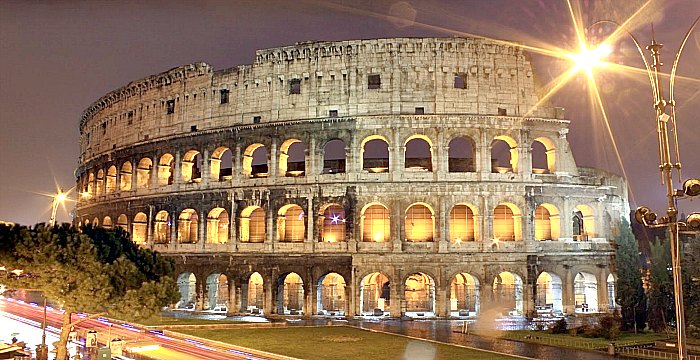
:: Colosseum ::
|
|
|
Colosseum
The Colosseum, the iconic symbol of the city, was elected as one of the
New Seven Wonders of the World (2007), it is located in one of the most
beautiful areas of the capital: not far from the heart of Rome, the
Capitol, next to the Roman Forum, has its own underground station, to
ensure an easy landing, and at the same time, rapid movements to reach
the most important areas of the city.
Picturesque centurions welcome the curiousest tourists and going on
across the timeless setting of Fori Imperiali, you arrive in Piazza
Venezia, merger to the famous Via del Corso, where you will find the
most important high fashion shop windows.
Its construction started in 72 AD under Emperor Vespasian, and was
completed in 80 AD during Titus reign, with further modifications made
under Domitian. Apparently its name derives from a nearby colossal
statue of the Sun God of Nero. The huge elliptical amphitheatre had a
seating capacity of 50,000 spectators and was used for gladiatorial
contests and public spectacles, such as re-enactments of famous battles,
celebrations or dramas.
The Colosseum consists of 3 levels placed on top of one another,
reaching a total height of 49 metres. It is made of huge square
travertine and tufa blocks placed on top of one another without any
mortar and connected by means of metal pins.
|
|
Don't miss "show" in Rome
M
•
O
•
U •
T •
H O
•
F T •
R •
U •
T •
H
|
Roman places worth to be seen |
|
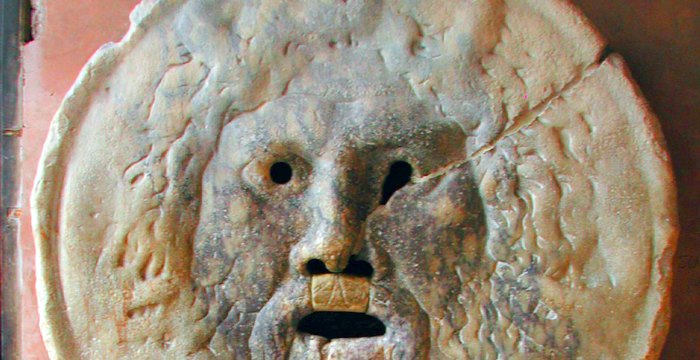
:: Mouth of Truth ::
|
|
|
Bocca della Verità
THE MOUTH OF TRUTH Piazza Bocca della Verità
The famous Mouth of Truth, hedged in the portico of the medieval Church
of Santa Maria in Cosmedin, is visited by thousands of tourists a day.
It seems that one of the most beloved tourist attractions is nothing
more than a manhole cover, in particular the cover of the Cloaca Maxima,
one of the most important sewage systems of Rome, some stretches of
which are still used today!
It was made even more famous by the film Roman Holiday starring Gregory
Peck and Audrey Hepburn.
The legend tells that if one told a lie with one's hand in the mouth of
the sculpture, it would be bitten off.
Just remember the film scene in which Gregory Peck pretends to have his
hand cut off. Rumour has it that the actress believed in the legend and
therefore that her scared expression in the movie was real!
HOW TO GET THERE: B line underground, Circo Massimo station; by walking
from Piazza Venezia following Via del Teatro Marcello
VISITING HOURS: 9:00 a.m. to 1:00 p.m. and 3:00 p.m. to 6:00 p.m.
.
|
|
|
Don't miss "show" in Rome
H
•
I
•
S •
T •
O •
R •
I •
C C
•
E •
N •
T •
E •
R
|
Roman places worth to be seen |
|
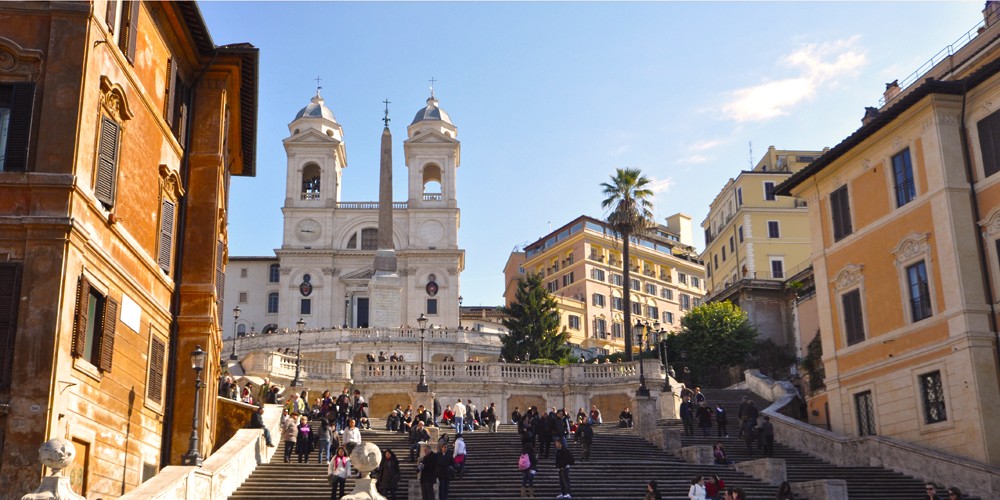
:: The historic centre of Rome ::
|
|
|
| The historic centre of Rome Enclosed by the Aurelian
walls, is delimited on the west by the Tiber river and on the East by
Via del Corso, in 1980 it has been declared world heritage site by
UNESCO. Among the countless narrow streets and tangled alleys you come
across lively squares, smart coffee bars, renaissance palaces and
ancient ruins such as the Colosseum, the Pantheon, Navona square, Campo
de Fiori. Famous churches and large museums, where to admire the
greatest masterpieces by Michelangelo, Raphael, Caravaggio and Bernini,
can be just around the corner. There are an estimated 25000 places of
historic and archaeological interest in the very heart of Rome that has
the power to impress anyone who has the chance to see them. The hub of
Rome is also the centre of the political life of the nation.
The best way to go about Rome's historic centre is on foot, but if you
would rather use public transportation, you can catch the 40 or 64 bus
lines, that leave from Termini station, stop at Largo Torre Argentina,
and go on along Corso Rinascimento. At the sides of this large road are
Campo de Fiori, Piazza Farnese and the Ghetto to the south, the Pantheon
and Navona square to the north.
DON’T MISS
Ancient Rome: The south part of Rome's historic centre, where impressive
monuments will take you back in time to relive the glory days of Roman
Empire. Absolutely not to be missed: Colosseum, Imperial Fora, Domus
Aurea, Capitoline Hill, Palatine Hill.
Historic centre: A maze of tangled alleys and beautiful squares, baroque
churches and ancient ruins. Get lost among the narrow streets to come
across Rome’s many secrets, like talking statues or little fountains,
and admire the works by great architects Bernini and Borromini. Not to
be missed: Pantheon, Navona square, Campo de Fiori.
Trident: The fashionable side of Rome: take a stroll around the many
smart boutiques and ateliers of famous stylists, luxury hotels and chic
restaurants. Walk from Piazza del Popolo, along Via del Corso to Spanish
Steps, and reach Trevi Fountain where you can throw a coin and make a
wish.
Vatican City, Borgo, Prati: The religious Rome or Rome of the Popes,
centre of Christianity. Don’t miss Saint Peter’s Basilica, Vatican
Museums, Castel Sant’Angelo.
.
|
|
|
Don't miss "show" in Rome
T
•
R
•
A •
S •
T •
E •
V •
E •
R •
E
|
Roman places worth to be seen |
|
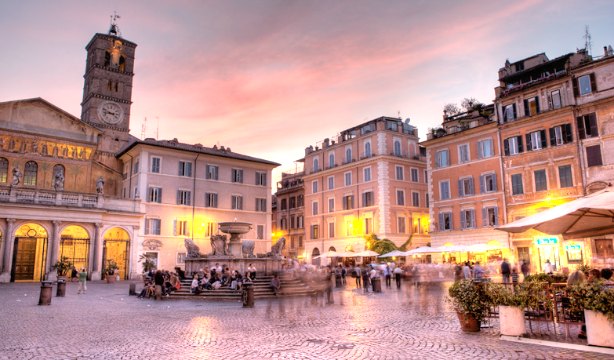
:: Trastevere ::
|
|
|
| Trastevere Trastevere or Trestevere in local dialect,
is rione XIII of Rome, and it lies on the west bank of the Tiber. Its
name comes from the Latin trans Tiberim, meaning "beyond the Tiber".
In Trastevere young and old people, locals and tourists alike spend
their evenings roaming in the narrow cobbled streets lined by medieval
houses, eating in a typical Roman restaurant, and drinking in one of the
several pubs situated in the area.
Thanks to its many typical restaurants, pubs, pizzerias, as well as the
little and stylish shops, Trastevere remains one of the most lively and
picturesque districts of Rome.
The maze of narrow streets leads to beautiful squares such as Piazza
Trilussa, gathering point for the young at night, or Piazza Santa Maria
in Trastevere, which features the Basilica di Santa Maria in Trastevere
(Basilica of Our Lady's in Trastevere ) boasting a XIII century mosaic
on the upper side of the façade.
Did You Know..?
At the very beginning of Rome’s history, Trastevere belonged to the
hostile Etruscans. Rome conquered it to gain control of the river from
both banks, but was not interested in building on that side of the river.
In fact, the only connection between Trastevere and the rest of the city
was a small wooden bridge called the Pons Sublicius. Thanks to the area
partial isolation and its cosmopolitan environment, the people of
Trastevere, known as trasteverini, were a sort of population of their
own, famous for their tenacity, pride and honesty.
The beauty of the local women boasting dark eyes and hair and regular
features also had a wide appeal.
In the Middle Ages Trastevere had narrow, winding, irregular streets: a
real maze with a strong contrast between the huge mansions of the rich
and the small houses of the poor. The streets had no pavement until the
end of the 1400s, when Pope Sixtus IV decided to renovate the area. For
the paving project bricks were initially chosen, but these were soon
replaced by sampietrini (cobble stones), because they were more suitable
for carriages.
.
|
|
|
Don't miss "show" in Rome
P
•
I
•
A •
Z •
Z •
A V
•
E •
N •
E •
Z •
I •
A
|
Roman places worth to be seen |
|
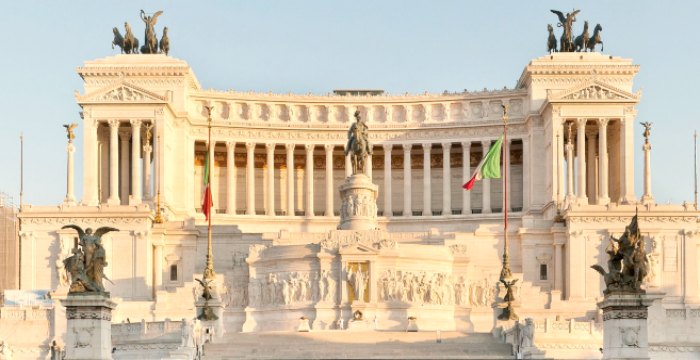
:: Piazza Venezia ::
|
|
|
Piazza Venezia
Piazza Venezia is a major circus and the central hub of Rome, Italy, in
which many thoroughfares intersect, like Via dei Fori Imperiali and Via
del Corso. It takes its name from Venice ("Venezia" in Italian), after
the Venetian Cardinal, Pietro Barbo (later Pope Paul II) who had built
Palazzo Venezia, a palace set next to the nearby church of Saint Mark,
the patron saint of Venice. Palazzo Venezia was the former embassy of
the city of the Republic of Venice to Rome.
The piazza or square is at the foot of the Capitoline Hill and next to
Trajan's Forum. The main artery, the Viale di Fori Imperiali starts
there, leading past the Roman Forum and to the Colosseum. It is
dominated by the imposing Monument to Vittorio Emanuele II, first king
of Italy. In 2009, during excavations for the Rome C Metro Line, ancient
remains of what has been identified as emperor Hadrian's Athenaeum were
unearthed in the middle of the square.Close from the famous Piazza
Venezia, you will find Navona Place, Forums, Colosseum, the shopping
area. the best point for nightlife lovers.
|
|
|
Don't miss "show" in Rome
T
•
E •
R •
M •
I •
N •
I S
•
T •
A •
T •
I •
O •
N
- M
•
E •
T •
R •
O
|
Roman places worth to be seen |
|
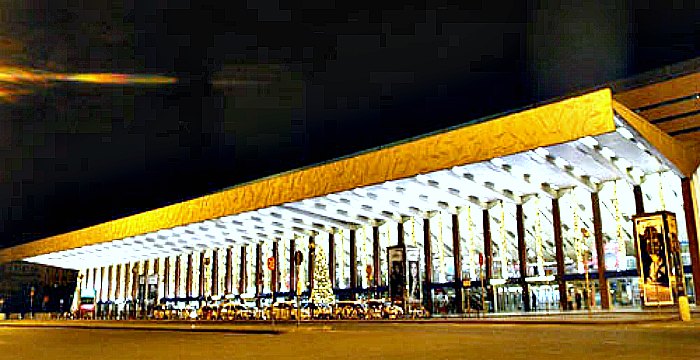
:: Termini Station
::
|
|
|
Termini Station and the Metro of Rome
Termini Station is very central, close to Venice Place and the downtown
shopping district, and there are the two metro lines: line A (identified by the
red color) and line B (blue). This two lines intersect them at Termini
Station, where you will be able to change from one line to another, that will ensure you faster and agiler movements (hours
of operation: Monday-Tuesday and Sunday from 5.30 to 23.30, Friday and
Saturday from 5.30 to 01.30).
One metro ride costs 1,50 euros and tickets are available at every
underground station using the self-service machines or going to the
provided front desks. If you have to use public transportation in Rome,
we recommend you to buy day tickets, surely most convenient compared to
a single ride.
The buses and the metro use the same tickets so you can transfer from
one to the other, the price also is the same and you can usually buy
them in newsstands or at a tobacconist.
Inspections are infrequent, especially on buses, but when you get on the
bus, you must time-stamp the ticket in a yellow machine on the bus,
after which it is valid for travel for the time shown on the ticket.
Similarly with tickets for underground: the tickets must be time-stamped
in a machine at the entrance of the station before you get on the
subway. At the Termini station there are many terminals of buses to
every direction.
In Rome the underground is considered an enough safe area but be careful
to your money and valuables and don’t leave your bags or backpacks open.
Riding the metro you will probably meet different improvised singers,
they’ll offer their performance in exchange for money.
Rome Transportation |
Lonely Planet |
Frommers Rome |
Michelin Travel and Tourism |
Alitalia |
Trenitalia
When
in Rome do as the Romans do! |
|
|
|